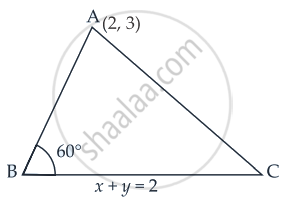Advertisements
Advertisements
प्रश्न
The vertex of an equilateral triangle is (2, 3) and the equation of the opposite side is x + y = 2. Then the other two sides are y – 3 = `(2 +- sqrt(3)) (x - 2)`.
विकल्प
True
False
उत्तर
This statement is True.
Explanation:
Let ABC be an equilateral triangle with vertex (2, 3) and the opposite side is x + y = 2 with slope –1.
Suppose slope of line AB is m.
Since each angle of equilateral triangle is 60°.
∴ Angle between AB and BC
tan 60° = `|(-1 - m)/(1 + (-1)m)|`
⇒ `sqrt(3) = |(1 + m)/(1 - m)|`
⇒ `sqrt(3) = +- ((1 + m)/(1 - m))`
Taking (+) sign,
`sqrt(3) = (1 + m)/(1 - m)`
⇒ `sqrt(3) - sqrt(3)m = 1 + m`
⇒ `sqrt(3)m + m = sqrt(3) - 1`
⇒ `m(sqrt(3) + 1) = sqrt(3) - 1`
⇒ `m = (sqrt(3) - 1)/(sqrt(3) + 1)
⇒ `m = (sqrt(3) - 1)/(sqrt(3) + 1) xx (sqrt(3) - 1)/(sqrt(3) - 1)`
⇒ `m = (3 + 1 - 2sqrt(3))/(3 - 1)`
= `2 - sqrt(3)`
Taking (–) sign,
`m = 2 + sqrt(3)`
So, the equations of other two lines are y – 3 = `(2 +- sqrt(3))(x - 2)`
APPEARS IN
संबंधित प्रश्न
Draw a quadrilateral in the Cartesian plane, whose vertices are (–4, 5), (0, 7), (5, –5) and (–4, –2). Also, find its area.
Find the distance between P (x1, y1) and Q (x2, y2) when :
- PQ is parallel to the y-axis,
- PQ is parallel to the x-axis
Find the value of x for which the points (x, –1), (2, 1) and (4, 5) are collinear.
Find the angle between the x-axis and the line joining the points (3, –1) and (4, –2).
Find the values of k for which the line (k–3) x – (4 – k2) y + k2 –7k + 6 = 0 is
- Parallel to the x-axis,
- Parallel to the y-axis,
- Passing through the origin.
Find the slope of the lines which make the following angle with the positive direction of x-axis:
\[\frac{2\pi}{3}\]
Find the slope of a line passing through the following point:
(−3, 2) and (1, 4)
Find the slope of a line passing through the following point:
\[(a t_1^2 , 2 a t_1 ) \text { and } (a t_2^2 , 2 a t_2 )\]
State whether the two lines in each of the following are parallel, perpendicular or neither.
Through (9, 5) and (−1, 1); through (3, −5) and (8, −3)
State whether the two lines in each of the following is parallel, perpendicular or neither.
Through (6, 3) and (1, 1); through (−2, 5) and (2, −5)
Consider the following population and year graph:
Find the slope of the line AB and using it, find what will be the population in the year 2010.

Find the angle between the X-axis and the line joining the points (3, −1) and (4, −2).
Find the angle between X-axis and the line joining the points (3, −1) and (4, −2).
A quadrilateral has vertices (4, 1), (1, 7), (−6, 0) and (−1, −9). Show that the mid-points of the sides of this quadrilateral form a parallelogram.
Find the equation of a line which is perpendicular to the line joining (4, 2) and (3, 5) and cuts off an intercept of length 3 on y-axis.
Find the equation of the strainght line intersecting y-axis at a distance of 2 units above the origin and making an angle of 30° with the positive direction of the x-axis.
Find the equations of the altitudes of a ∆ ABC whose vertices are A (1, 4), B (−3, 2) and C (−5, −3).
Prove that the points (2, −1), (0, 2), (2, 3) and (4, 0) are the coordinates of the vertices of a parallelogram and find the angle between its diagonals.
If two opposite vertices of a square are (1, 2) and (5, 8), find the coordinates of its other two vertices and the equations of its sides.
Write the coordinates of the image of the point (3, 8) in the line x + 3y − 7 = 0.
The coordinates of the foot of the perpendicular from the point (2, 3) on the line x + y − 11 = 0 are
The equation of a line passing through the point (7, - 4) and perpendicular to the line passing through the points (2, 3) and (1 , - 2 ) is ______.
If one diagonal of a square is along the line 8x – 15y = 0 and one of its vertex is at (1, 2), then find the equation of sides of the square passing through this vertex.
The intercept cut off by a line from y-axis is twice than that from x-axis, and the line passes through the point (1, 2). The equation of the line is ______.
Find the equation of the line passing through the point (5, 2) and perpendicular to the line joining the points (2, 3) and (3, – 1).
The tangent of angle between the lines whose intercepts on the axes are a, – b and b, – a, respectively, is ______.
The points (3, 4) and (2, – 6) are situated on the ______ of the line 3x – 4y – 8 = 0.
The line which passes through the origin and intersect the two lines `(x - 1)/2 = (y + 3)/4 = (z - 5)/3, (x - 4)/2 = (y + 3)/3 = (z - 14)/4`, is ______.
